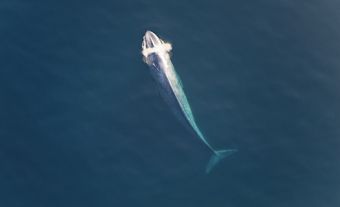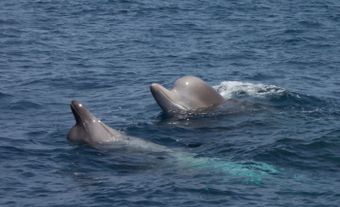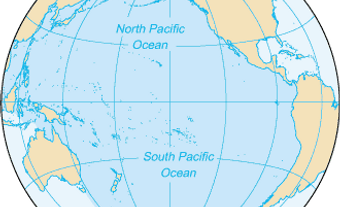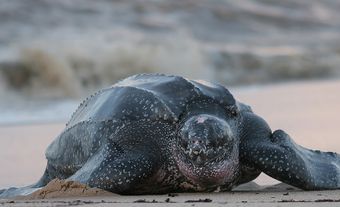The grey whale (Eschrichtius robustus) is a baleen whale found in the North Pacific Ocean. It is known for its very long migrations and seafloor feeding. Due to its habit of staying near the shore and curiosity around small ships, it is a favourite among whale watchers. Researchers generally group grey whales into three populations: the Western Pacific population, the Northern Pacific migratory population, and the Pacific Coast Feeding Group (PCFG). While all three populations migrate through waters on Canada’s west coast, the most well-known residents in Canadian waters are from the PCFG. Many of these individuals live off the coast of British Columbia year-round.

Physical Description
Grey whales are named for their dark grey colour at birth. As they reach adulthood, they turn light to brown grey. Their skin is usually mottled with darker and lighter patches and riddled with barnacles and whale lice. Calves are up to 5 m long and weigh up to 1 tonne. As adults, grey whales are generally 12–15 m long — about the length of a school bus — and weigh 30–40 tonnes. Females tend to be slightly larger than males. Unlike many other whales, the grey whale lacks a dorsal fin. Instead, it has a dorsal hump followed by a series of small bumps along its back.
Geographic Distribution, Habitat and Migration

Western and Northern Pacific grey whales undertake some of the longest migrations of any known mammal. A single round trip may total up to 22,500 km — more than half the Earth’s circumference. All three populations migrate south in the winter to four specific shallow lagoons off Mexico’s west coast, where calves are born. Then, the whales return north to their distinctive summer feeding grounds. The Western Pacific population spends the summer in the Sea of Okhotsk, off the coast of Russia; the Northern Pacific population in the Bering, Chuckchi and Beaufort seas; and the Pacific Coast Feeding Group (PCFG) in waters ranging from Northern California to Alaska.
Grey whales remain near the coast most of the time, unless migration requires they swim elsewhere. The Northern Pacific population is by far the largest, numbering about 20,000 individuals. Both the Western Pacific population and PCFG number in the low hundreds.
Lifespan and Reproduction
Grey whales live up to 80 years or more. At ages 5–12, individuals become sexually mature. Mating often involves three or more whales, and at times, several partners within a season. Although there is some mixing, individuals tend to mate within their population group. Gestation lasts about a year. For 6–8 months newborns can consume up to 180 L per day of their mother’s rich, 53 per cent fat milk.
Behaviour

Grey whales are usually found alone or in small groups. They stay near shores to feed in shallow water and possibly to avoid their main predator, the killer whale. They mostly feed in the summer, usually on benthic and epibenthic invertebrates (on the seafloor and just above it). They do this by taking in mouthfuls of water and mud or sand, then using their tongue to push the water and mud out through their baleen plates, which retain the prey. Grey whales eat up to 1,200 kg of food per day. Due to their unique feeding style, they play an important ecological role. Through their excrement, grey whales circulate nutrients from the seafloor to the water above, and the tiny invertebrates that make it out of their mouth become food for fishes and birds near the surface.
Since they tend to stay in shallow waters, grey whales generally only dive for 3–5 minutes at a time, or up to 15 minutes in some cases. They emit mostly low-frequency sounds, probably for communication and navigation.
Relationship to Humans
Grey whales were hunted by Indigenous communities in the United States, Canada and Russia for millennia, including the Nuu-chah-nulth of Vancouver Island’s western coast. Today, the International Whaling Commission (IWC) allows small subsistence quotas to only two Indigenous groups: the Chukchi in Russia and the Makah in Washington. That said, despite the IWC’s ruling, the Makah are still forbidden from hunting grey whales by American authorities, although this may change.
Grey whales were hunted commercially for their oil from the 18th century to 1979. As a result, the Atlantic population is extirpated, and the Pacific population dipped to under 2,000 individuals.
Threats
Killer whales are the grey whale’s main predator. All other threats come from human activities. These include entanglement in fishing gear, collisions with ships, disturbances from whale-watchers, noise, toxic spills, and a decline in prey. Noise pollution can come from many sources, ranging from ship traffic to seismic exploration (often related to oil and gas projects) to chronic noise from the operation of wind farms. Since grey whales rely on sound for communication and navigation, these disruptions are significant. In addition, the grey whale’s feeding method makes it particularly vulnerable to toxic spills. Not only do surface spills, such as oil spills, pose risks, but toxic chemicals that deposit on the seafloor may be directly ingested. Decline in prey is mostly from habitat change (due to human projects) and climate change–driven ocean acidification. However, climate change is also the cause of a reduction in Arctic ice cover, which opens up new feeding grounds to grey whales. Because of this, climate change may overall benefit grey whales in the short term. Long-term effects are more difficult to assess.
Conservation

Hunting grey whales was banned as early as 1937 by the International Agreement for the Regulation of Whaling (IARW), which was replaced in 1946 by the International Convention for the Regulation of Whaling (ICRW). However, it took several decades for all concerned nations to get on board, and for illegal whaling to get under control. Some unreported catches continued until 1979. While the Western Pacific grey whale population is still recovering from whaling, the Pacific Coast Feeding Group’s (PCFG’s) numbers are stable and the growth of the Northern Pacific population is considered a conservation success. The Convention on International Trade in Endangered Species of Wild Fauna and Flora (CITES) forbids any commercial trade of grey whale products.
The International Union for Conservation of Nature (IUCN) designates grey whales as “Least Concern,” although the Western Pacific population is still considered in danger of extinction. In 1981, Canada withdrew from the ICRW, but the whale remains protected by federal law. The Committee on the Status of Endangered Wildlife in Canada and the Species at Risk Act consider the Northern Pacific population not at risk and both the PCFG and Western Pacific populations endangered (see also Endangered Animals in Canada).

 Share on Facebook
Share on Facebook Share on X
Share on X Share by Email
Share by Email Share on Google Classroom
Share on Google Classroom



